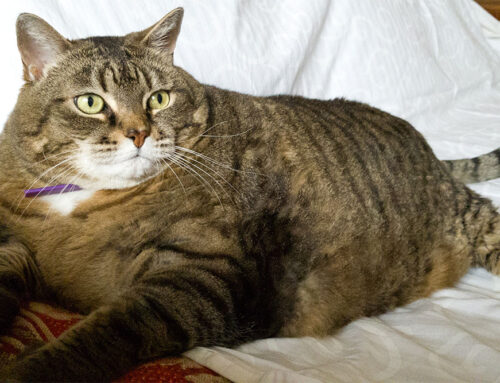Is there less bounce in your senior cat’s pounce? Is your purr-fect predator more likely to balk than stalk? Is your mighty hunter more interested in chasing Z’s than their motorized mouse toy?
If so, they may be suffering from feline arthritis.
But, because cats hide their discomfort to avoid appearing weak, owners may miss common arthritis signs and unintentionally force their cat to live with chronic and relentless pain. If your cat is slowing down or simply not acting like themselves, check out Bayview Animal Hospital’s guide to understanding and recognizing feline arthritis.
Feline arthritis explained
Arthritis has become a catch-all term for age-related aches and pains, but is actually a chronic degenerative condition caused by inflammation in one or more joints, including the spine. As cats age, their healthy joint cartilage wears away, and every motion becomes painful and restricted. Coarse bone gradually replaces the previously smooth, shock-absorbing cartilage, and spur-like projections are created, triggering more inflammation and pain with each grinding movement.
According to clinical studies, arthritis signs were detected in 60% of cats older than 6 years of age, and 90% of cats older than 12, yet the condition remains as elusive and subtle as cats themselves. Here are four signs that your cat could be suffering from arthritis pain.
#1: Your cat appears stiff or slow-moving
Anyone who has ever experienced pain or discomfort has probably also learned to adapt—we may move gingerly or more slowly trying to avoid unpleasant feelings. Arthritic cats may appear to move in slow motion, especially when rising after resting or transitioning from one posture to another (e.g., standing to sitting). Arthritic joints are typically stiff because they not only have reduced cartilage, but they also no longer produce adequate joint fluid, which is a thick substance that lubricates and minimizes friction.
Arthritic cats may appear to warm up when they move and lose their stiffness, but this may lessen as the disease progresses.
#2: Your cat’s behavior has changed
Pain alters how we perceive the world and how we interact with our surroundings. Arthritic cats may express their pain through uncharacteristic behavior changes, such as:
- Isolation — Painful cats may demonstrate increased hiding behavior, avoid social interactions, or sleep more than normal.
- Fear — Cats may appear hypersensitive to their environment and react strongly to previously benign stimuli (e.g., loud noises, dropped items, boisterous activity).
- Aggression — Painful cats may aggressively defend themselves when they feel threatened. If a cat associates physical affection with their pain, they may bite, scratch, or flee when their owner attempts to pet or lift them.
- Disinterest — Arthritic cats may show decreased or no enthusiasm for their favorite activities, such as toy play, sitting on a perch, or seeking physical affection.
#3: Your cat’s movement patterns are abnormal
Uncomfortable cats may alter their posture or gait to compensate for weak or painful areas. Cats may stand with an arched or rounded back, move in a semi-crouched position, or avoid specific home areas that they associate with painful movement. These may include:
- Elevated surfaces or furniture — Jumping up or down creates excessive force on the cat’s front or rear limbs. Arthritic cats may want to break larger jumps into smaller steps.
- Stairs — Arthritic cats may pause and rest on long staircases rather than climbing up or down all at once.
- Slick floors — Cats with weakened muscles may feel unstable on smooth floors.
Although lameness is a classic arthritis sign, painful cats may visibly limp only if their condition is severe.
#4: Your cat’s grooming habits have changed
Cats are fastidious by nature and spend 30% to 50% of their day grooming, so any change in your cat’s grooming routine or appearance can indicate an underlying health problem. Arthritic cats may avoid grooming specific areas (e.g., the hips or urogenital region) because they are difficult to reach, or they may over-groom painful joints. Signs may include:
- Matted hair
- Greasy or unkempt appearance
- Urine or fecal matter on coat
- Visible undercoat
- Hairless areas
- Irritated or inflamed skin
Help for your arthritic cat

If your cat is demonstrating arthritis signs or other mobility issues, schedule an appointment at Bayview Animal Hospital. Your cat’s veterinarian will perform a thorough examination, including gait assessment and joint palpation and range of motion looking for pain signs or mobility restriction. They may recommend additional testing, such as X-ray imaging or blood work.
Fortunately, veterinary treatment can alleviate pain and discomfort in arthritic cats and they can enjoy a relatively normal life. Treatment is typically multi-modal and involves medication and environmental changes, which include:
- Pain medication — Several safe, effective medications can manage feline pain by blocking pain signals and decreasing joint inflammation.
- Weight management — Fat tissue not only puts extra pressure on your cat’s joints, but also is pro-inflammatory and exacerbates arthritis pain. Our team can help your cat slim down safely while maintaining muscle mass.
- Lifestyle changes — Pet ramps, orthopedic beds, heated surfaces, and low-impact exercise can help your cat feel more comfortable.
- Follow-up exams — Because arthritis is chronic and progressive, your cat’s treatment plan will change as they age. Regular communication with your Bayview Animal Hospital veterinarian will ensure that we stay one paw-step ahead of your cat’s pain.
Feline arthritis is a sneaky threat to cat comfort and health, but increased awareness can spotlight this hidden and elusive condition. If your cat is experiencing a change in their mobility or behavior, don’t delay—schedule an examination at Bayview Animal Hospital, and let us whisk-er away their pain.






Leave A Comment